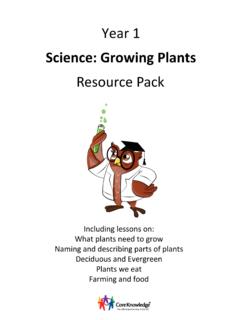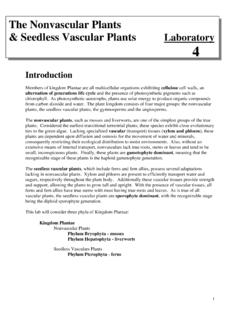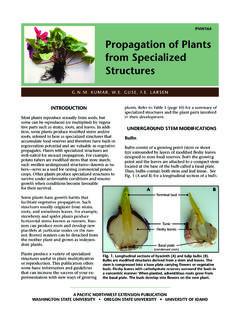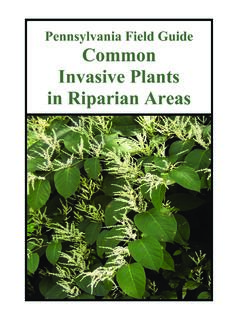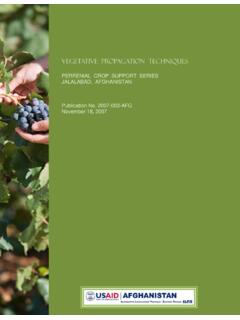Transcription of Plant Fact Sheet - USDA PLANTS
1 Plant fact Sheet Status LONGLEAF PINE Please consult the PLANTS Web site and your State Department of Natural Resources for this Plant 's Pinus palustris P. Mill. current status ( threatened or endangered species, Plant Symbol = PIPA2 state noxious status, and wetland indicator values). Contributed by: USDA NRCS National Plant Data Description Center Pinus palustris P. Mill., longleaf pine, is found in the Atlantic and Gulf coastal plains from southeastern Virginia to central Florida and west to eastern Texas, and in the Piedmont region and Valley and Ridge province of Georgia and Alabama. Longleaf pine is a long-lived, native, evergreen conifer with scaly bark. Needles are in bundles of 3; they are shiny, dark green, and 8 to 15 inches long. Cones are 6 to 8. inches long. Mature trees attain a height of 100 to 120 feet and 2 feet in diameter. Its seeds are the largest of all southern pines. It has extensive lateral roots and a taproot that grows 8 to 12 feet long. Adaptation and Distribution Longleaf pine grows best in a warm, wet, temperate climate with an annual precipitation range of 43 to 69.
2 Peterson USDA NRCS NPDC. inches. Although the species occurs in a wide variety @ PLANTS of upland and flatwood sites, it is common on sandy, infertile, well-drained soils, mostly below 660 feet Alternate Names elevation. longstraw pine, southern yellow pine, Georgia pine Longleaf pine is distributed throughout the Southeast. Uses For a current distribution map, please consult the Erosion Control: Longleaf pine is a highly Plant Profile page for this species on the PLANTS . recommended species for reforestation of dry, Website. infertile, deep sands in the southeastern It is has limited potential for rehabilitation of mine spoils. Establishment Longleaf pine stands are successfully established by Wildlife: Birds and small mammals eat the large either seeding or vegetative reproduction. Seeds seeds, ants feed on germinating seeds, and razorback (including dormant seeds if prechilled) can be sown hogs eat the roots of seedlings. This species provides in the fall or spring, pressed into the soil at densities excellent habitat for bobwhite quail, white-tailed from 15 to 75 seedlings per square foot.
3 Seeds deer, wild turkey, and fox squirrel. Old-growth germinate 1 to 2 weeks following seedfall. stands provide nesting habitat for the red-cockaded Germination requires mineral soil. The seed's large woodpecker. size and persistent wing prevent it from penetrating through the litter. Seedlings are stemless after one Timber: The wood is often clear, straight, and with growing season and this lasts from 2 to many years. few defects and used for timber and ship building. During this grass-stage, the seedling develops an extensive root system, and the root collar increases in Recreation and Beautification: Longleaf pine needles diameter. When the root collar diameter approaches are used for mulch. Resin is used in the naval stores 1 inch in diameter, height growth begins. A field- industry for gum turpentine and rosin production. grown seedling grows 10 feet in 3 years once height growth is initiated. Branch production is delayed until the seedling reaches 10 to 16 feet in height. Plant Materials < >.
4 Plant fact Sheet /Guide Coordination Page < >. National Plant Data Center < >. To file a complaint of discrimination write USDA, Director, Office of Civil Rights, Room 326-W, Whitten Building, 14th and Vegetative propagation is usually done by grafting. Independence Avenue, SW, Washington, DC 20250-9410 or call If grass-stage seedlings are top-killed, they can sprout 202-720-5964 (voice or TDD). USDA is an equal opportunity from the root collar. Once height growth begins, provider and employer. sprouting ability decreases rapidly. Read about Civil Rights at the Natural Resources Convervation Service. Heavy grazing can reduce tree density, significantly reducing establishment and causing crop failure. Management Longleaf pine is intolerant to both shade and competition. With frequent fire, uneven-aged pure stands form park-like savannahs. Because longleaf pine regenerates in openings created by dead trees, small clusters of trees of the same age are dispersed throughout the stand. In the absence of frequent fire, the species is replaced by hardwoods and other southern pines; this hastens the decline of mature longleaf pine.
5 Lightning ignited fires are pivotal to perpetuation of longleaf pine on a site indefinitely. Excessive grazing reduces young tree density. Pests and Potential Problems The main disease of longleaf pine is brown-spot needle blight (Scirrhia acicola). Other diseases include pitch canker, annosus root rot, and cone rust. Insects that attack longleaf pine include black turpentine beetle, bark beetles, and seed bugs. Cultivars, Improved, and Selected Materials (and area of origin). No cultivars are currently recommended. Seeds and seedlings are commercially available from woody Plant seed companies. The number of seeds per pound ranges from 3,000 to 7,000. Prepared By & Species Coordinator: Lincoln Moore, Forest Biologist USDA NRCS National Plant Data Center, Baton Rouge, LA. Edited: 05 Feb2002 JLK; 060802 jsp For more information about this and other PLANTS , please contact your local NRCS field office or Conservation District, and visit the PLANTS Web site< > or the Plant Materials Program Web site < >.
6 The Department of Agriculture (USDA) prohibits discrimination in all its programs and activities on the basis of race, color, national origin, sex, religion, age, disability, political beliefs, sexual orientation, and marital or family status. (Not all prohibited bases apply to all programs.) Persons with disabilities who require alternative means for communication of program information (Braille, large print, audiotape, etc.) should contact USDA's TARGET Center at 202-720-2600 (voice and TDD).











